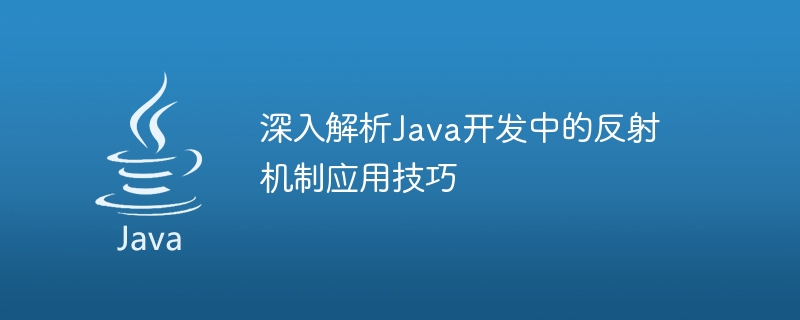

Java 開発におけるリフレクション メカニズムのアプリケーション スキルの詳細な分析
はじめに:
Java 開発では、リフレクション メカニズムは強力で広く使用されているテクノロジです。 。これにより、プログラムは実行時にクラス、インターフェイス、メンバー変数、メソッドなどの情報を検査および操作できます。リフレクション メカニズムは、動的プロキシ、アノテーション処理、フレームワーク開発など、多くのシナリオで重要な役割を果たします。この記事では、読者がこのテクノロジをよりよく習得して活用できるように、Java 開発におけるリフレクション メカニズムの適用テクニックを詳細に分析します。
1. リフレクション メカニズムの原理と基本概念
リフレクション メカニズムは、Java プログラミング言語でダイナミクスを実現するための基礎です。実行時にクラスとオブジェクトの構造と動作を分析することにより、クラスに対する動的な操作を実装します。リフレクション メカニズムでは、主に次のコア クラスとインターフェイスが関係します。
2. アプリケーション スキル
動的プロキシを例として、インターフェイス Calculator があると仮定して、各メソッドを計算する前にログを出力したいとします。動的プロキシを使用すると、次のことを実現できます。
public class CalculatorProxy implements InvocationHandler {
private Object target;
public CalculatorProxy(Object target) {
this.target = target;
}
public Object invoke(Object proxy, Method method, Object[] args)
throws Throwable {
System.out.println("Before method " + method.getName() + " is called...");
Object result = method.invoke(target, args);
System.out.println("After method " + method.getName() + " is called...");
return result;
}
}
public class Main {
public static void main(String[] args) {
Calculator calculator = new CalculatorImpl();
CalculatorProxy calculatorProxy = new CalculatorProxy(calculator);
Calculator proxy = (Calculator) Proxy.newProxyInstance(
calculator.getClass().getClassLoader(),
calculator.getClass().getInterfaces(),
calculatorProxy);
proxy.add(1, 2);
}
}動的プロキシを通じて、add() メソッドの実行前後にログを出力できます。このようにして、プロキシ クラスを通じてメソッドを強化できます。
たとえば、カスタム アノテーション MyAnnotation を定義し、そのアノテーションをメソッドに追加できます:
@Retention(RetentionPolicy.RUNTIME)
@Target(ElementType.METHOD)
public @interface MyAnnotation {
String value();
}
public class MyClass {
@MyAnnotation("Hello, World!")
public void myMethod() {
// method implementation
}
}次に、リフレクションを使用してアノテーションを読み取り、解析します。
public class AnnotationProcessor {
public static void main(String[] args) throws NoSuchMethodException {
MyClass myClass = new MyClass();
Method method = myClass.getClass().getMethod("myMethod");
if (method.isAnnotationPresent(MyAnnotation.class)) {
MyAnnotation annotation = method.getAnnotation(MyAnnotation.class);
System.out.println(annotation.value());
}
}
}上記のコードを通じて、メソッドのアノテーションを動的に取得して解析できます。
Spring フレームワークを例として取り上げます。これは、リフレクションを使用して依存関係の注入を実装できます。 Spring はクラスのアノテーションをスキャンしてインスタンスを動的に作成し、インスタンスの依存関係を対応するメンバー変数に注入します。
@Component
public class MyService {
@Autowired
private MyRepository myRepository;
// other methods
}
@Component
public class MyRepository {
// implementation
}
public class Main {
public static void main(String[] args) {
ApplicationContext context = new AnnotationConfigApplicationContext(Config.class);
MyService myService = context.getBean(MyService.class);
// use myService
}
}リフレクションを通じて、Spring フレームワークは動的に MyRepository オブジェクトを作成し、MyService クラスに注入できます。
概要:
この記事では、Java 開発におけるリフレクション メカニズムのアプリケーション スキルについて詳しく分析します。動的プロキシ、アノテーション処理、フレームワーク開発などの実践的な例を通じて、読者はリフレクション メカニズムをより深く理解し、適用することができます。反射メカニズムは強力ですが、使用には注意が必要です。実行時にリフレクションを使用すると、パフォーマンスの低下やコードの読みやすさなどの問題が発生する可能性があります。したがって、リフレクション メカニズムを使用する場合は、長所と短所を比較検討し、適切な最適化を行う必要があります。
以上がJava開発におけるリフレクション・メカニズムの適用スキルの詳細な分析の詳細内容です。詳細については、PHP 中国語 Web サイトの他の関連記事を参照してください。